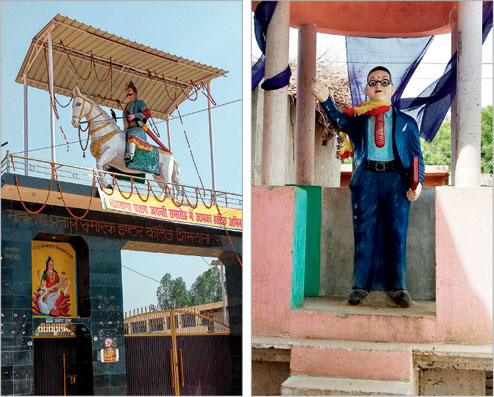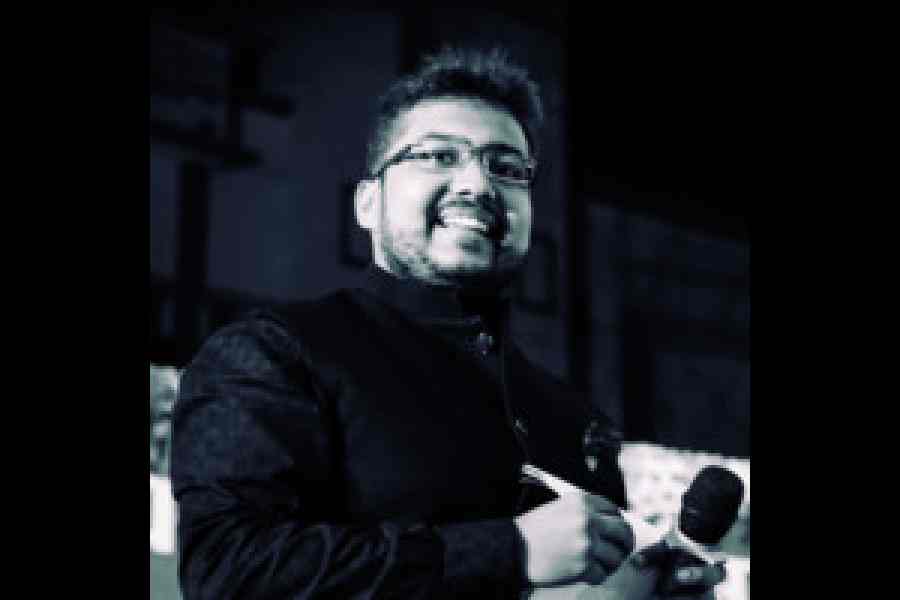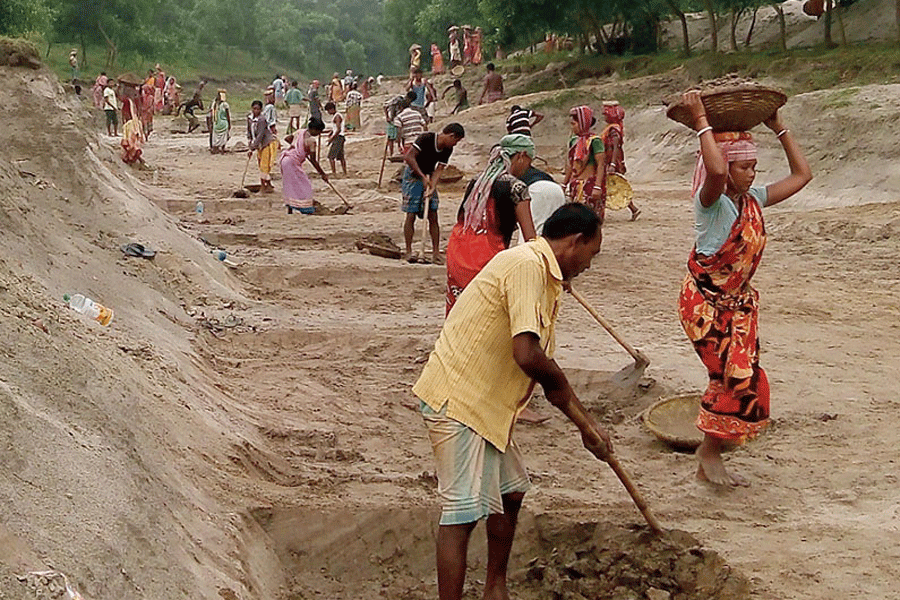THE JAGGED EDGES OF A LEGACY BATTLE UNDER YOGI


Shabbirpur, (UP), May 11: Memo Devi, 38, remembers exactly how the recent tensions between her Dalit community and the Thakurs started in this pocket of western Uttar Pradesh, 700km from Lucknow.
What lit the first spark was the Thakurs' objection to a roadside statue of Babasaheb Bhimrao Ambedkar pointing a finger at their passing womenfolk.
The strife slow-burned and eventually exploded in a clash in which a person died. It also brought back into focus a cauldron from which the BJP says it wants to climb out but finds itself more deeply enmeshed than ever.
The alleged aggression from the upper caste Thakurs has coincided with the spectacular rise of Yogi Adityanath, who heads the BJP government in Uttar Pradesh and who is a Thakur.
Into the statue strife has been added a controversy over Maharana Pratap, the Rajput hero whom the Thakurs idolise and the BJP has been building up as a historical figure to counter Akbar, the Mughal emperor, in a legacy battle that has become all too familiar after the party came to power at the Centre three years ago. Yesterday, too, chief minister Adityanath had heaped praise on Rana Pratap and labelled Akbar an invader.
A surprise element in the explosive cocktail has been the assertiveness of the Dalits -something similar to the resolute spirit that had scalded the Sangh parivar on the University of Hyderabad campus and the alleged response to which led to the suicide of Rohith Vemula.
At Shabbirpur in Saharanpur, the day was April 14, the birthday of Ambedkar. The Jatavs of Shabbirpur were poised to install a statue to the great man on a concrete pedestal inside a temple to Sant Ravidas, where the Dalits worshipped, just beside the main village road.
A group of young Thakurs walked across from their side of the village to say the statue could not be put up without permission from the authorities.
"If you install the statue, we'll cut its wrist off with a sword," Memo Devi quoted the leader of the Thakurs as saying.
"Our bahus and betis (daughters-in-law and daughters) use the road; how can the statue point fingers at them? If you must have a statue, place it on the ground and not on a pedestal where it overlooks the road; or put it behind the temple."
One standard pose for Ambedkar statues in Uttar Pradesh is for the icon to stand on a pedestal holding a copy of the Constitution in one hand while his other arm is raised with a finger pointing in the air.
In Shabbirpur, where the dominant Thakur and Jatav castes respectively account for 1,200 and 700 voters, the Thakurs' objections prompted the administration to deny permission for the statue, dampening the Jatavs' Ambedkar Jayanti celebrations. The statue remains locked in a room.
The hurt was perceptible in the voice of Rajesh Kumar, 30, even yesterday as he said: "Babasaheb is more than God for us. We had never imagined the Thakurs would object to a statue of Babasaheb, who gave the country its Constitution."
Rajesh, brother of the village's Jatav pradhan, Shiv Kumar, alleged that the Thakurs had got "more aggressive" since Adityanath became chief minister on March 19.
"We often see them chanting 'Jai Shri Ram' and campaigning for a Ram temple in Ayodhya. They seem to feel the government is theirs and they can do whatever they want."
The antagonism simmering since April 14 in the village, 28km from Saharanpur town, erupted into violence on May 5 morning. The day was the supposed birth anniversary of Maharana Pratap, who had fought Akbar.
As some 50 Thakur youths, sporting saffron bandannas and carrying stereo speakers playing loud "DJ music", reached the portion of the road flanked by Dalit homes, the Jatavs blocked their way. Pradhan Shiv Kumar led the protesters.
"You didn't let us install a Babasaheb statue without permission to celebrate his birthday, so how can you hold this procession without similar permission?" a Jatav youth asked.
The young Thakurs had been headed for Simlana village, 4km away, to celebrate the Maharana's birthday. Apparently, the Thakurs had not imagined that the Jatavs would challenge them so aggressively even after the Bahujan Samaj Party's defeat in the region in the February-March Assembly polls.
Mayawati's party, which had won four of the seven Assembly seats in Saharanpur in 2012, drew a blank this time.
As the roadside argument threatened to turn violent, the pradhan called Badgaon police station, 2km away. But clashes broke out before the police arrived.
Outnumbered, the Thakurs phoned their caste brethren who had gathered for the celebrations in Simlana. The Jatavs claimed that over 2,000 Thakur youths rushed to Shabbirpur and attacked them with sticks and swords.
"Our homes were torched, the women beaten and molested. The attackers chanted 'Jai Shri Ram' and 'Ambedkar murdabad'," said Suggan Jatav, 70, who said his home was attacked too.
Suggan alleged that the police arrived only after the rampage ended after more than an hour.
.jpg)
Sushila Devi, 65, claimed the Thakurs vandalised the local temple, tried to break the idol of Sant Ravidas, and urinated on it. She says some youths took off their own clothes and abused the women. The Thakurs deny these allegations.
By the time the battle stopped, a 35-year-old Thakur, Sumit Kumar, was dead. Some 10 Jatavs and six Thakurs were admitted to hospital, local sources said.
The Thakurs accuse the Jatavs of killing Sumit and of having pre-planned the clash. The Jatavs claim that Sumit suffocated while torching their homes.
Four FIRs, three by the Thakurs and one by the Jatavs, have been lodged. The police arrested nine Thakurs and eight Jatavs under various charges, including murder. Many men from both communities have fled. The village continues to simmer.
"Shabbirpur and a couple of other villages are like tinderboxes. They can explode anytime. We are keeping a close watch," said Rajendra Singh Tyagi, a sub-inspector with Badgaon police station.
Shyam Singh, an elderly Thakur in Shabbirpur, claimed the people who had attacked the Jatavs were outsiders. He acknowledged that a few "misguided" youths from the village had protested the statue installation and unnecessarily aggravated the situation.
He agreed that Adityanath's elevation had turned the Thakur youths more bellicose.
"Yes, some misguided youths are showing aggression but the larger community wants peace. The Thakurs and Jatavs depend on each other and should co-exist peacefully," he said.
Villagers in the region said that never before had birthday celebrations for Maharana Pratap been organised on such a scale. Posters announcing a "grand saffron march" by a certain "Sri Ram Sena" had been plastered across villages.
With the rise of Hindutva aggression, the Dalits too have stepped up Ambedkar Jayanti celebrations, with more such events held this year than ever before.
The Shabbirpur fire seems to be spreading to other villages in western Uttar Pradesh.
Four days later, on May 9, violence broke out in Saharanpur town when a little-known Dalit outfit, the Bhim Army, protested the authorities' denial of permission for a " maha panchayat" to demand justice for Shabbirpur's Jatavs.
A large mob resorted to vandalism, set fire to government vehicles and attacked journalists. The angry Dalits claimed the administration and the media were biased against them.
The same day, Adityanath was in Meerut city, about 100km from Saharanpur. His visit to a Jatav locality, Shergadhi, was seen as an attempt to reach out to the Dalits.
Adityanath, however, faced protests from a group of Dalits for failing to visit the Ambedkar statue in the locality. The protesters also condemned the administration's alleged bias in investigating the Shabbirpur incident.
Satish Prakash, a Dalit activist and a professor at Meerut University, said the Jatavs' blockade of the Thakurs' May 5 procession was partly a reaction to an April 20 incident in nearby Dhudli village.
BJP activists, led by local MP Raghav Lakhanpal, had organised a march in Dhudli without the administration's permission to celebrate Ambedkar's birth anniversary. The marchers clashed with the village's Muslims.
"We learnt the BJP workers had raised chants of 'Jai Shri Ram' and 'UP mein rehna hai toh Yogi, Yogi karna hai (to live in Uttar Pradesh you must chant the Yogi's name)'," said Vinay Ratan Singh, national president of the Bhim Army, which describes itself as a non-violent welfare organisation for Dalits.
Vinay smelt a rat in the BJP's action: "Ambedkar's birthday is celebrated on April 14; why did the BJP organise the event on April 20?"
He claimed the Dalits of Dhudli had celebrated Ambedkar's birthday at a small event on April 14, in which the Muslims too had participated.
"The Dalits viewed the Dhudli incident as an effort by the BJP to pit them against the Muslims. With Adityanath in the chair, the BJP is trying to co-opt the Dalits under the Hindutva umbrella," Prakash said. "This, I feel, is meeting with aggressive protests from the Dalits."
Prakash said the Bahujan Samaj Party's defeat in a region considered its stronghold had prompted the Dalits to turn more assertive of their rights.
"The slogan of 'Jai Shri Ram' is being countered with 'Jai Bhim'. Politically, it's significant," Prakash added.










